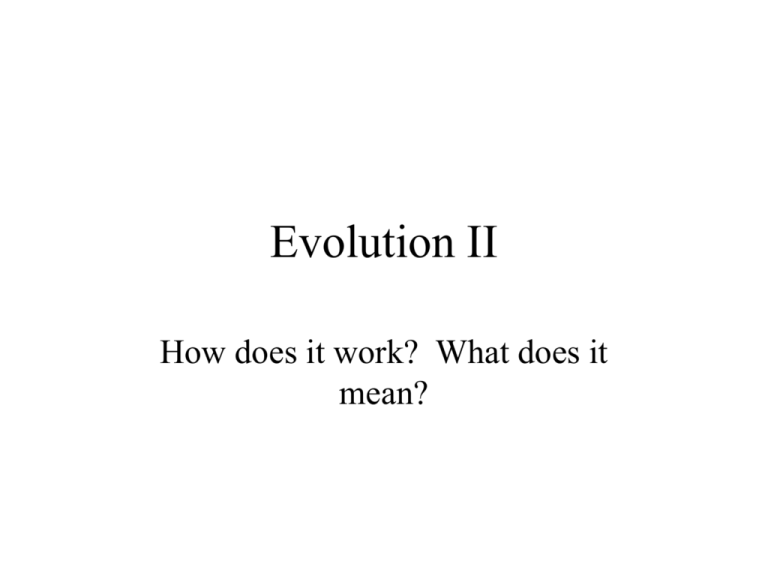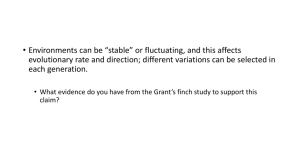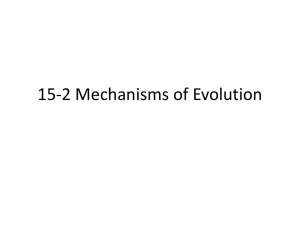power point here
advertisement

Evolution II How does it work? What does it mean? topics • • • • • Patterns Mechanisms Speciation Macroevolution trends • Evolution and how it works • Evidence: – Fossils – Homology – Embryology • Mis-conceptions Example 1: beetles on a diet % of a population of beetles is green; a % is brown One year, a drought limits food supply As a result of this environmental stress, the next generation of beetles are smaller After another generation, the % of green and brown beetles changes Is this an example of evolution? NO! Why? All changes -even those from environmental stress or limited resources - are not evolution. What do you need to see to know you are looking at evolution? • Change in the “gene pool” - the total genetic makeup of a population (the actively interbreeding portion of a species; a species consists of interbreeding or potentially interbreeding individuals) • So if changes in the gene pool define evolution, what causes change in this? Changes in the gene pool (the genetic composition of a population) are caused by: 1. Mutation 2. Gene flow, or migration 3. Genetic drift 4. Natural selection Introduction of genetic variation: 1. Mutation - changes in DNA, usually from a “copying error” but also from external causes (ex, radiation). A single mutation can have a large effect, but usually accumulation of mutations over time produces change. Most mutations are neutral. Mutations are random 2. Gene flow - introducing new genes to a population from emigrants, including: sexual recombination - shuffling genes during fertilization and cell division What is genetic drift? In every generation some individuals leave behind slightly more offspring (and their genes) than other individuals. As a result, the next generation has more of the genes of the reproducing ancestors than genes of the ancestors with fewer offspring. As these descendents in turn create offspring, so more of their genes will be transmitted to the next generation than those ancestors who had fewer offspring. No adaptations are involved, it’s just a matter of statistical change over time. Natural Selection Variation in traits; green and brown beetles Variation in reproductive success. If one color of beetle is preferentially eaten by a predator, more of the other color will remain to reproduce Heredity: more of the brown beetles will pass their genes on to offspring End result: as these 3 steps continue, greater and greater numbers of brown beetles will appear in successive generations; the composition of the gene pool changes over time = evolution Some questions: • does the beetle in our example need to change color in order to survive? • Is a brown beetle “better”? • How is our green beetle/brown beetle example of natural selection different from “inheritance of acquired characteristics” of Lamarck? An important feature of natural selection is “fitness” What does this mean? A genotype’s fitness is defined by its ability to successfully pass on its genes to the next generation. What defines reproductive success? survival to reproduce acquire a mate successful reproduction behavior (in mate acquisition and parenting) gentoo “survival of the fittest” does not necessarily mean big, strong, mean, etc, etc. It may refer to protective coloration, metabolic needs, lengthy parenting, etc, etc. What is “adaptation”? • Modification of the phenotype that enhances fitness or reproductive success • There are limits on the amount of adaptation in a population…rates on the processes that produce genetic variation are low, and there are also constraints on the phyletic history. Ex, a lobster can’t adapt by losing it’s exoskeleton…that’s “hard wired” into what defines an arthropod. • Every generation that reproduces IS adapted; there aren’t “losers”. • Adaptation doesn’t happen FOR a reason…it can only be viewed historically; there is no genetic modification to produce a “goal” of adaptation What is microevolution? • The change in gene frequency in a population which may lead to speciation (creation of a new species) • Ex: our green and brown beetles: if you determine the genetic makeup of the beetle population in successive years and notice a change in ratios of genes, you are studying microevolution This important question is, “How did this happen?” Mechanisms for microevolution: Mutation (although it’s not likely that you would see this after only 1 generation) Gene flow - introduction of new genes into the population by emigration or sexual recombination genetic drift - random changes in the % of various genes Natural selection - brown beetles escape predation and reproduce more frequently Speciation species = a population of interbreeding or potentially interbreeding individuals Speciation = a lineagesplitting event that produces 2 species Speciation happens through geographic isolation The gene pool for a species becomes geographically separated and due to subtle environmental differences between the two regions, the gene pool diverges over time. Geographic isolation can also happen without a physical barrier. If the geographic distribution of a species is very wide, those populations on one “side” won’t actively interbreed with populations on the other “side,” and over time, genetic drift will result in their divergence. Do we see speciation happening today? 3 examples: The 1995 Hurricane Marilyn washed several tree logs, and resident lizards, to a new Caribbean island (Anguilla). Iguana iguana had not been recorded on Anguilla before. Biologists are waiting to see if these new emigrants survive and reproduce, and how, over time I.iguana’s gene pool may change (= evolution) and if that will result in a new species of iguana. Stay tuned! The spotted owl, Strix occidentalis, is widespread in the western U.S. The populations in the south are slightly different from those in the Pacific NW. Current studies on owl genetics suggests that the gene pools are diverging. Speciation appears to be happening. Experimental results….. Drosophila populations physically separated are fed different foods. After several generations they are reintroduced to one another to see if they mate or are reproductively isolated. Fruit flies fed one food source preferred to mate with other fruit flies fed the same food (the food source altered their feeding behavior). Studies continue to see if their gene pools have diverged (if speciation has occurred yet). What speciation would look like in the fossil record: Species accumulate morphologic change over time, much of which is represented in unconformities and bedding planes. Sometimes the entire sequence of intermediate forms IS preserved The “gaps” or missing intermediary steps are real, reflecting the very rapid burst of evolution that creates a new species, followed by long periods of stasis. How phyletic gradualism happens: Incremental morphologic change over time. results from changes in the gene pool over time. The graph represents an imaginary distribution of genes in a species (think of the human genome project for all humans!). If an environmental change applies a stress on a species, those having certain genes that enable them to adapt will successfully reproduce and individuals with more of those genes will appear in subsequent generations. Over time the entire gene pool will accumulate these changes and the distribution will change. This type of gradual change in the genotype will result in incremental changes in the phenotype. Another model for speciation: The slow change in the genetic makeup of a population as a result of reduced gene flow. Perhaps this happens as a result of a population exploiting a new niche or food source, changing its behavior as a result, and diminished interbreeding. Continued over time, reduced gene flow will isolate the populations. Are we seeing this type of speciation now? Apple maggot flies have historically eaten/laid eggs in apples. More recently they have also started to eat/reproduce in hawthorne apples. Since insects tend to mate with other insects that eat the same food, apple maggot flies are interbreeding with other apple maggot flies and not with hawthorne maggot flies. Over time will these gene pools isolate? Another mode of speciation: “punctuated equilibrium” • Morphology (and gene frequency) stays relatively constant over long periods of time followed by rapid change and the appearance of a new species. • Populations living in the geographic limits of the species develop slightly different genotypes because they are living in less than ideal environments (temp extremes, water depth extremes, etc). • Environmental change stresses the populations living in the optimal environments..they have difficulty successfully reproducing. If the geographically distant populations are more successful reproducing under these new conditions, their genotype will allow for more successful reproduction. Thanks to the Berkeley Museum website for these illustrations http://evolution.berkeley.edu/evosite/evohome.html






